It's time to Brawl!
As you may have seen elsewhere today, Brawl decks are now available on Magic: The Gathering Arena for you to play! (It's available in paper when Throne of Eldraine releases on October 4!) I'm sure many of you have already taken the opportunity to go in and immerse yourself in the world of Eldraine—and these decks!
Now, if you remember from my last article about Brawl, I talked a bunch about why we were doing Brawl now, and what to expect. But for a brief recap: Throne of Eldraine is where we're really firing off the format on all cylinders. We knew it would take some time to get here, so it was on hiatus for a while—but now it's back and better than ever, with preconstructed decks, Brawl on MTG Arena, and in-store play. (You can check out the above linked article for more details.)
Now that I've laid the foundation out for why we're doing these decks, I want to talk about how we went about creating them, what to expect of them—and, of course, full decklists. Oh. . .and because the MTG Arena decklists differ slightly from the printed decklists, I actually have four preview cards for you to top everything all off.
Ready to dig in? Let's get started!
Bringing in the Community
Brawl is a casual, and often social, play format, and for it to work and be successful, it was crucial that the community was finding it fun and had input. Us finding something fun isn't nearly as important as all of you finding something fun!
So, as the architect on the Brawl decks, I worked with our teams to try something a little unusual and unorthodox. (And what I am about to say will, no doubt, get aspiring Magic designers around the world to bolt up in their chairs.) What was it? Well, if we wanted a community focus, we should involve the community.
So, we reached outside of Wizards to design the decks.
Here's how it worked. Melissa DeTora was put in charge of design for the decks. She, of course, works here at Wizards on Play Design and even sits right next to me so we could be in constant communication. She selected the colors based on needs for Brawl commanders and designed several of the cards. But then she led a team of four designers from around the country, all external to Wizards and under contract, to actually design the decks and provide feedback. This crew was a mix of different styles and backgrounds, each trying to grab different aspects of the community. Each designer led the design of a different deck.
First up was Emma Handy. You might recognize her from her excellent articles over at Star City Games, and her competitive success as well. She had always noted an interest in design and was an excellent deck builder, so we wanted to loop her in. She was in charge of the green-white-blue "Wild Bounty" deck.
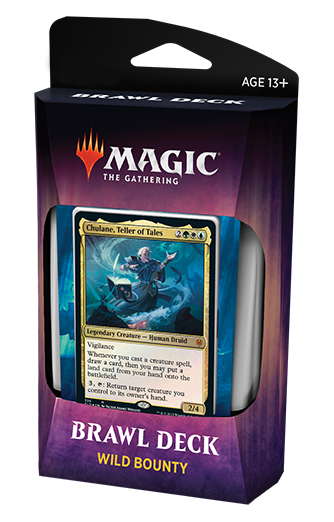
Next up, moving along the spectrum of competition, was Henry Davis. (Who, in the time since, has been brought on as a contractor to work with our digital teams. Good work, Henry!) Henry is a local player who has done a lot with community building in the Seattle area—including building up Magic groups, clubs, and working with Card Kingdom to do broadcasting. He also plays competitively and loves building new decks. He led the black-red-green "Savage Hunter" deck.
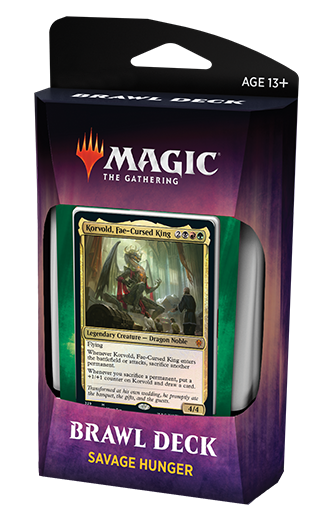
Next, Jeremy Geist. You might recognize this name—he was a runner up of the Great Designer Search 3. And while we weren't able to bring him on board into Wizards immediately, we liked his work and kept him in mind for this project. He brought a very sharp design eye to the table and did great work on both mechanic suggestions as well as deck design. He led the white-blue-black "Faerie Schemes" deck.
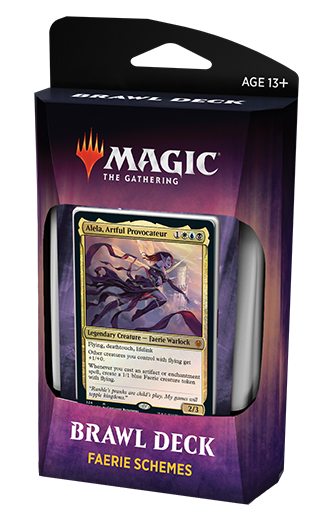
The final designer we reached out to was Stephanie Schelble. Hailing from New York, she brought a very useful and more casual eye to the table. It was really great for the team to have this wide range of perspectives, which really helped hone the decklists further—and Stephanie definitely added to that. She led the red-white-black "Knights' Charge" deck.
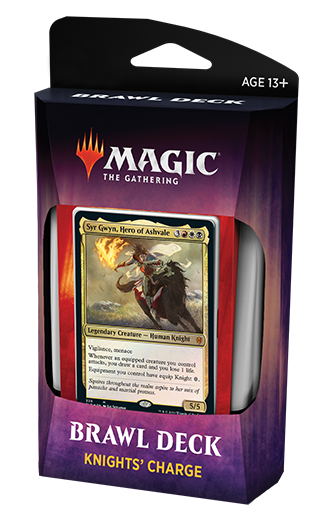
Each designer was given access to the Standard-legal cards in their colors, put in communication with each other, and they were off to the races! The team ran for a while, guided by Melissa.
This was a really neat process, and it was wonderfully valuable to get the perspectives of others outside of our normal Wizards members on this. It's also a great example of how the architecture process can work: I gave Melissa direction on what to do and guided her design of the decks, and she in turn helped guide these four excellent designers on what to do.
At the end of the process, Melissa came back and rebalanced the decks, plus did plenty of playtesting to get them just right. Speaking of Melissa. . .why don't I just let her explain her design philosophy behind the decks herself? Hey Melissa—want to talk about the decks for a moment?
Yes? Perfect! I'm going to go get a sip of water and let Melissa take the reins for a moment. Go for it, Melissa!
Hey, everyone! I'm Melissa DeTora, lead designer of the Brawl decks. I want to talk to you about some of our goals for Brawl.
Our main goal was to get people to play more Brawl! Brawl offers a much different experience than Commander, uses a smaller card pool, and has a lot fewer cards to "compete" with. Plus, it's a great starting point for a Commander or Standard deck, too! There are more viable strategies available because they don't get outclassed by the broader, more powerful Commander card pool.
One of Brawl's limitations was that the mana bases were inherently weak. Standard only uses two different strong dual land cycles per year, and some more budget options like Gates and gain lands, but with only two years' worth of cards, there just aren't many options. Therefore, one of our goals was to make the mana bases stronger. We added Command Tower and designed a new strong mana rock to make the mana work better and to be another option for Commander.
Our second goal for Brawl was to make cool new decks using Throne of Eldraine themes and offer a variety of play patterns to satisfy all types of players.
Chulane
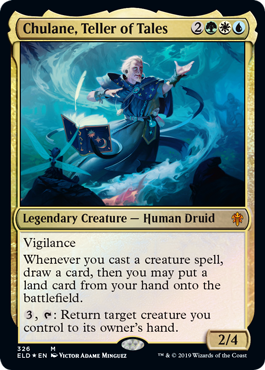
A "Spikier" deck that has less synergy but a higher power level. We wanted to use the new Adventure mechanic from Throne of Eldraine, so this deck is about ramping, casting lots of creatures and spells, and rebuying your creatures to get multiple uses out of them.
Korvold
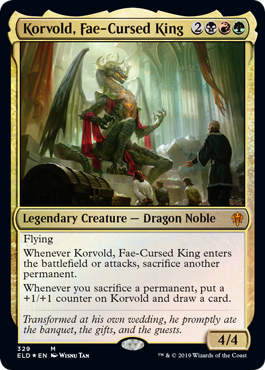
This deck for Johnny players has lots of obvious synergy and combos. It uses the Food mechanic from ELD and sacrifices permanents for value.
Alela
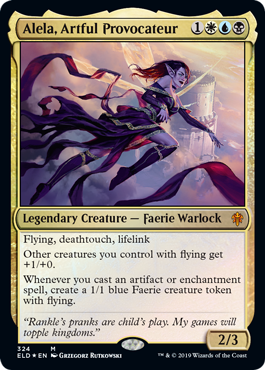
This deck has more of a mix of synergy and power. The combos are less obvious, and there are lots of things to discover. It uses the artifact and enchantment theme from ELD, and has a light flying theme as well.
Syr Gwyn

For the player who wants to play creatures and attack. This deck is easier to play than the others. It's all about Knights and Equipment.
After we settled on the topline strategies for the decks, I had our external contractors build initial lists, and we started playtesting. From there, we discovered the decks' weaknesses and holes, and designed cards to fill them.
One thing that is true of Brawl is that the power level is inherently lower than Standard, since you only get access to one of each card. Because of that, games tend to stall out quickly. We wanted to make sure each deck had the right finishers and the right amount of card flow. That's the main reason for most of the designs.
Secondly, since these new cards were not going to be in ELD Draft Booster packs (they will, however, be in Collector Boosters), we had to be careful about their power level for Standard. If these cards were top-tier Standard cards, then card availability may have been an issue. However, we wanted to make cool and powerful cards that had appeal in Brawl and Commander. Our strategy was to make the cards more multiplayer-focused.
I'll be back in a bit with some card stories. But for now, back to you, Gavin!
Perfect! And now I'm nice and hydrated for the rest of this article. . .or at least the next couple sections.
Finally, that wasn't the end of our community involvement. As someone deeply entrenched in the community, one of the big things I've been doing is reaching out to prominent community members to get their takes on what we're making. For formats like Brawl and Commander, which are so focused on social play, getting the thoughts of people who live and breathe the format but don't work inside Wizards is something I like doing.
So, to that end, I turned to Jimmy Wong and Josh Lee Kwai of the Command Zone—two of the biggest names in Commander—to review some upcoming social play products.
One of the things we had Josh do during his visit here was review the Brawl cards with an eye toward Commander—and he provided lots of great feedback that Melissa took under her wing when making changes to these cards. (Along with feedback to us for Commander (2019 Edition), and some other products as well.) We wanted to make cards that would not only appeal to Brawl players but Commander players as well, and I'm so glad we were able to incorporate that into the decks.
Looking Inside Brawl
One of the biggest notes from the community right away, upon Brawl's announcement, was that they wished it would be on MTG Arena. So, after working with that team, I am incredibly glad these Brawl decks are now live on MTG Arena. If you've had a chance to check them out, hopefully you'll agree. And if you haven't, go check it out right now! The team did a really great job on it, and, truly, I tip my hat to all of them for making this a reality.
That said, another thing about MTG Arena is that currently there is no multiplayer functionality. And, as Melissa noted above, some of the new Brawl cards were made with multiplayer in mind. So, as a result, there were four new cards that got trimmed from the MTG Arena version to make way for cards that played better in one-on-one.
Since you won't see them in MTG Arena, let's take a peek at them now. These cards will be in the decks you'll be able to find in stores, starting when Throne of Eldraine releases.
In the "Savage Hunter" deck, rather than Izoni, Thousand-Eyed and Mask of Immolation, you'll find these two new cards perfect for multiplayer games with that Jund sacrifice deck:
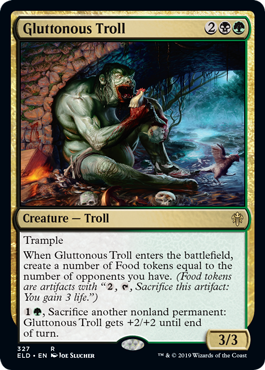
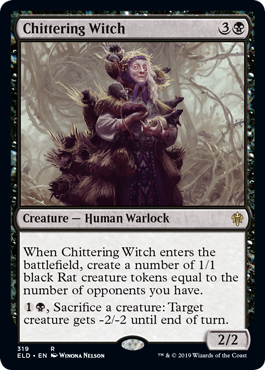
And in the "Knights' Charge" deck, rather than Shivan Dragon and Tajic, Legion's Edge, you'll find these two multiplayer-attacking powerhouses:
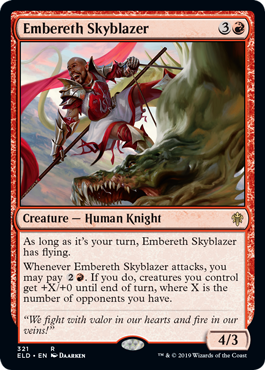
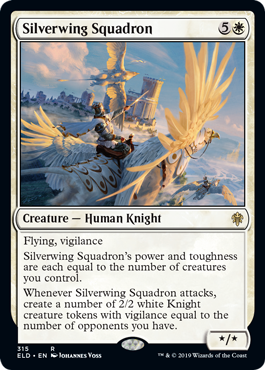
As Melissa alluded to earlier, this is one of the ways they could make cards that were powerful for Brawl, without risking that the set would have cards you would badly need for Standard Constructed. They're plenty powerful in multiplayer, so go check them out!
And if you want to see the full decklists in one place, well. . .you've come to the right spot! Here they are in all their wild wonder—with the caveat that the cards won't display properly until they're added to Gatherer in a future update:
Wild Bounty


COMMANDER: Chulane, Teller of Tales
a:48:{i:0;O:8:"stdClass":3:{s:9:"card_meta";O:8:"stdClass":2:{s:5:"title";s:16:"Faerie Formation";s:22:"field_card_image_front";a:0:{}}s:4:"type";s:8:"creature";s:10:"deck_count";s:1:"1";}i:1;O:8:"stdClass":3:{s:9:"card_meta";O:8:"stdClass":2:{s:5:"title";s:15:"Steelbane Hydra";s:22:"field_card_image_front";a:0:{}}s:4:"type";s:8:"creature";s:10:"deck_count";s:1:"1";}i:2;O:8:"stdClass":3:{s:9:"card_meta";O:8:"stdClass":2:{s:5:"title";s:13:"Thorn Mammoth";s:22:"field_card_image_front";a:0:{}}s:4:"type";s:8:"creature";s:10:"deck_count";s:1:"1";}i:3;O:8:"stdClass":3:{s:9:"card_meta";O:8:"stdClass":2:{s:5:"title";s:15:"Tome of Legends";s:22:"field_card_image_front";a:0:{}}s:4:"type";s:8:"artifact";s:10:"deck_count";s:1:"1";}i:4;O:8:"stdClass":3:{s:9:"card_meta";O:8:"stdClass":2:{s:5:"title";s:12:"Parhelion II";s:22:"field_card_image_front";a:0:{}}s:4:"type";s:8:"artifact";s:10:"deck_count";s:1:"1";}i:5;O:8:"stdClass":3:{s:9:"card_meta";O:8:"stdClass":2:{s:5:"title";s:20:"End-Raze Forerunners";s:22:"field_card_image_front";a:0:{}}s:4:"type";s:8:"creature";s:10:"deck_count";s:1:"1";}i:6;O:8:"stdClass":3:{s:9:"card_meta";O:8:"stdClass":2:{s:5:"title";s:16:"Incubation Druid";s:22:"field_card_image_front";a:0:{}}s:4:"type";s:8:"creature";s:10:"deck_count";s:1:"1";}i:7;O:8:"stdClass":3:{s:9:"card_meta";O:8:"stdClass":2:{s:5:"title";s:20:"Biomancer's Familiar";s:22:"field_card_image_front";a:0:{}}s:4:"type";s:8:"creature";s:10:"deck_count";s:1:"1";}i:8;O:8:"stdClass":3:{s:9:"card_meta";O:8:"stdClass":2:{s:5:"title";s:9:"Time Wipe";s:22:"field_card_image_front";a:0:{}}s:4:"type";s:7:"sorcery";s:10:"deck_count";s:1:"1";}i:9;O:8:"stdClass":3:{s:9:"card_meta";O:8:"stdClass":2:{s:5:"title";s:17:"Hallowed Fountain";s:22:"field_card_image_front";a:0:{}}s:4:"type";s:4:"land";s:10:"deck_count";s:1:"1";}i:10;O:8:"stdClass":3:{s:9:"card_meta";O:8:"stdClass":2:{s:5:"title";s:17:"Temple of Mystery";s:22:"field_card_image_front";a:0:{}}s:4:"type";s:4:"land";s:10:"deck_count";s:1:"1";}i:11;O:8:"stdClass":3:{s:9:"card_meta";O:8:"stdClass":2:{s:5:"title";s:13:"Faerie Vandal";s:22:"field_card_image_front";a:0:{}}s:4:"type";s:8:"creature";s:10:"deck_count";s:1:"1";}i:12;O:8:"stdClass":3:{s:9:"card_meta";O:8:"stdClass":2:{s:5:"title";s:17:"Run Away Together";s:22:"field_card_image_front";a:0:{}}s:4:"type";s:7:"instant";s:10:"deck_count";s:1:"1";}i:13;O:8:"stdClass":3:{s:9:"card_meta";O:8:"stdClass":2:{s:5:"title";s:15:"Beanstalk Giant";s:22:"field_card_image_front";a:0:{}}s:4:"type";s:8:"creature";s:10:"deck_count";s:1:"1";}i:14;O:8:"stdClass":3:{s:9:"card_meta";O:8:"stdClass":2:{s:5:"title";s:16:"Keeper of Fables";s:22:"field_card_image_front";a:0:{}}s:4:"type";s:8:"creature";s:10:"deck_count";s:1:"1";}i:15;O:8:"stdClass":3:{s:9:"card_meta";O:8:"stdClass":2:{s:5:"title";s:17:"Rosethorn Acolyte";s:22:"field_card_image_front";a:0:{}}s:4:"type";s:8:"creature";s:10:"deck_count";s:1:"1";}i:16;O:8:"stdClass":3:{s:9:"card_meta";O:8:"stdClass":2:{s:5:"title";s:14:"Maraleaf Pixie";s:22:"field_card_image_front";a:0:{}}s:4:"type";s:8:"creature";s:10:"deck_count";s:1:"1";}i:17;O:8:"stdClass":3:{s:9:"card_meta";O:8:"stdClass":2:{s:5:"title";s:13:"Arcane Signet";s:22:"field_card_image_front";a:0:{}}s:4:"type";s:8:"artifact";s:10:"deck_count";s:1:"1";}i:18;O:8:"stdClass":3:{s:9:"card_meta";O:8:"stdClass":2:{s:5:"title";s:17:"Forbidding Spirit";s:22:"field_card_image_front";a:0:{}}s:4:"type";s:8:"creature";s:10:"deck_count";s:1:"1";}i:19;O:8:"stdClass":3:{s:9:"card_meta";O:8:"stdClass":2:{s:5:"title";s:12:"Prison Realm";s:22:"field_card_image_front";a:0:{}}s:4:"type";s:11:"enchantment";s:10:"deck_count";s:1:"1";}i:20;O:8:"stdClass":3:{s:9:"card_meta";O:8:"stdClass":2:{s:5:"title";s:15:"Spectral Sailor";s:22:"field_card_image_front";a:0:{}}s:4:"type";s:8:"creature";s:10:"deck_count";s:1:"1";}i:21;O:8:"stdClass":3:{s:9:"card_meta";O:8:"stdClass":2:{s:5:"title";s:16:"Circuitous Route";s:22:"field_card_image_front";a:0:{}}s:4:"type";s:7:"sorcery";s:10:"deck_count";s:1:"1";}i:22;O:8:"stdClass":3:{s:9:"card_meta";O:8:"stdClass":2:{s:5:"title";s:14:"District Guide";s:22:"field_card_image_front";a:0:{}}s:4:"type";s:8:"creature";s:10:"deck_count";s:1:"1";}i:23;O:8:"stdClass":3:{s:9:"card_meta";O:8:"stdClass":2:{s:5:"title";s:15:"Kraul Harpooner";s:22:"field_card_image_front";a:0:{}}s:4:"type";s:8:"creature";s:10:"deck_count";s:1:"1";}i:24;O:8:"stdClass":3:{s:9:"card_meta";O:8:"stdClass":2:{s:5:"title";s:17:"Silhana Wayfinder";s:22:"field_card_image_front";a:0:{}}s:4:"type";s:8:"creature";s:10:"deck_count";s:1:"1";}i:25;O:8:"stdClass":3:{s:9:"card_meta";O:8:"stdClass":2:{s:5:"title";s:14:"Paradise Druid";s:22:"field_card_image_front";a:0:{}}s:4:"type";s:8:"creature";s:10:"deck_count";s:1:"1";}i:26;O:8:"stdClass":3:{s:9:"card_meta";O:8:"stdClass":2:{s:5:"title";s:14:"Frilled Mystic";s:22:"field_card_image_front";a:0:{}}s:4:"type";s:8:"creature";s:10:"deck_count";s:1:"1";}i:27;O:8:"stdClass":3:{s:9:"card_meta";O:8:"stdClass":2:{s:5:"title";s:13:"Leafkin Druid";s:22:"field_card_image_front";a:0:{}}s:4:"type";s:8:"creature";s:10:"deck_count";s:1:"1";}i:28;O:8:"stdClass":3:{s:9:"card_meta";O:8:"stdClass":2:{s:5:"title";s:13:"Growth Spiral";s:22:"field_card_image_front";a:0:{}}s:4:"type";s:7:"instant";s:10:"deck_count";s:1:"1";}i:29;O:8:"stdClass":3:{s:9:"card_meta";O:8:"stdClass":2:{s:5:"title";s:13:"Gyre Engineer";s:22:"field_card_image_front";a:0:{}}s:4:"type";s:8:"creature";s:10:"deck_count";s:1:"1";}i:30;O:8:"stdClass":3:{s:9:"card_meta";O:8:"stdClass":2:{s:5:"title";s:11:"Sharktocrab";s:22:"field_card_image_front";a:0:{}}s:4:"type";s:8:"creature";s:10:"deck_count";s:1:"1";}i:31;O:8:"stdClass":3:{s:9:"card_meta";O:8:"stdClass":2:{s:5:"title";s:10:"Risen Reef";s:22:"field_card_image_front";a:0:{}}s:4:"type";s:8:"creature";s:10:"deck_count";s:1:"1";}i:32;O:8:"stdClass":3:{s:9:"card_meta";O:8:"stdClass":2:{s:5:"title";s:18:"Flower // Flourish";s:22:"field_card_image_front";a:0:{}}s:4:"type";s:7:"sorcery";s:10:"deck_count";s:1:"1";}i:33;O:8:"stdClass":3:{s:9:"card_meta";O:8:"stdClass":2:{s:5:"title";s:25:"Incubation // Incongruity";s:22:"field_card_image_front";a:0:{}}s:4:"type";s:7:"sorcery";s:10:"deck_count";s:1:"1";}i:34;O:8:"stdClass":3:{s:9:"card_meta";O:8:"stdClass":2:{s:5:"title";s:12:"Meteor Golem";s:22:"field_card_image_front";a:0:{}}s:4:"type";s:8:"creature";s:10:"deck_count";s:1:"1";}i:35;O:8:"stdClass":3:{s:9:"card_meta";O:8:"stdClass":2:{s:5:"title";s:15:"Firemind Vessel";s:22:"field_card_image_front";a:0:{}}s:4:"type";s:8:"artifact";s:10:"deck_count";s:1:"1";}i:36;O:8:"stdClass":3:{s:9:"card_meta";O:8:"stdClass":2:{s:5:"title";s:6:"Plains";s:22:"field_card_image_front";a:0:{}}s:4:"type";s:4:"land";s:10:"deck_count";s:1:"5";}i:37;O:8:"stdClass":3:{s:9:"card_meta";O:8:"stdClass":2:{s:5:"title";s:6:"Island";s:22:"field_card_image_front";a:0:{}}s:4:"type";s:4:"land";s:10:"deck_count";s:1:"4";}i:38;O:8:"stdClass":3:{s:9:"card_meta";O:8:"stdClass":2:{s:5:"title";s:6:"Forest";s:22:"field_card_image_front";a:0:{}}s:4:"type";s:4:"land";s:10:"deck_count";s:1:"6";}i:39;O:8:"stdClass":3:{s:9:"card_meta";O:8:"stdClass":2:{s:5:"title";s:17:"Azorius Guildgate";s:22:"field_card_image_front";a:0:{}}s:4:"type";s:4:"land";s:10:"deck_count";s:1:"1";}i:40;O:8:"stdClass":3:{s:9:"card_meta";O:8:"stdClass":2:{s:5:"title";s:16:"Blossoming Sands";s:22:"field_card_image_front";a:0:{}}s:4:"type";s:4:"land";s:10:"deck_count";s:1:"1";}i:41;O:8:"stdClass":3:{s:9:"card_meta";O:8:"stdClass":2:{s:5:"title";s:13:"Command Tower";s:22:"field_card_image_front";a:0:{}}s:4:"type";s:4:"land";s:10:"deck_count";s:1:"1";}i:42;O:8:"stdClass":3:{s:9:"card_meta";O:8:"stdClass":2:{s:5:"title";s:14:"Evolving Wilds";s:22:"field_card_image_front";a:0:{}}s:4:"type";s:4:"land";s:10:"deck_count";s:1:"1";}i:43;O:8:"stdClass":3:{s:9:"card_meta";O:8:"stdClass":2:{s:5:"title";s:18:"Selesnya Guildgate";s:22:"field_card_image_front";a:0:{}}s:4:"type";s:4:"land";s:10:"deck_count";s:1:"1";}i:44;O:8:"stdClass":3:{s:9:"card_meta";O:8:"stdClass":2:{s:5:"title";s:15:"Simic Guildgate";s:22:"field_card_image_front";a:0:{}}s:4:"type";s:4:"land";s:10:"deck_count";s:1:"1";}i:45;O:8:"stdClass":3:{s:9:"card_meta";O:8:"stdClass":2:{s:5:"title";s:13:"Tranquil Cove";s:22:"field_card_image_front";a:0:{}}s:4:"type";s:4:"land";s:10:"deck_count";s:1:"1";}i:46;O:8:"stdClass":3:{s:9:"card_meta";O:8:"stdClass":2:{s:5:"title";s:15:"Thornwood Falls";s:22:"field_card_image_front";a:0:{}}s:4:"type";s:4:"land";s:10:"deck_count";s:1:"1";}i:47;O:8:"stdClass":3:{s:9:"card_meta";O:8:"stdClass":2:{s:5:"title";s:24:"Chulane, Teller of Tales";s:22:"field_card_image_front";a:0:{}}s:4:"type";s:8:"creature";s:10:"deck_count";s:1:"1";}}
Knights' Charge


COMMANDER: Syr Gwyn, Hero of Ashvale
a:50:{i:0;O:8:"stdClass":3:{s:9:"card_meta";O:8:"stdClass":2:{s:5:"title";s:19:"Mace of the Valiant";s:22:"field_card_image_front";a:0:{}}s:4:"type";s:8:"artifact";s:10:"deck_count";s:1:"1";}i:1;O:8:"stdClass":3:{s:9:"card_meta";O:8:"stdClass":2:{s:5:"title";s:19:"Silverwing Squadron";s:22:"field_card_image_front";a:0:{}}s:4:"type";s:8:"creature";s:10:"deck_count";s:1:"1";}i:2;O:8:"stdClass":3:{s:9:"card_meta";O:8:"stdClass":2:{s:5:"title";s:18:"Embereth Skyblazer";s:22:"field_card_image_front";a:0:{}}s:4:"type";s:8:"creature";s:10:"deck_count";s:1:"1";}i:3;O:8:"stdClass":3:{s:9:"card_meta";O:8:"stdClass":2:{s:5:"title";s:15:"Knights' Charge";s:22:"field_card_image_front";a:0:{}}s:4:"type";s:11:"enchantment";s:10:"deck_count";s:1:"1";}i:4;O:8:"stdClass":3:{s:9:"card_meta";O:8:"stdClass":2:{s:5:"title";s:13:"Single Combat";s:22:"field_card_image_front";a:0:{}}s:4:"type";s:7:"sorcery";s:10:"deck_count";s:1:"1";}i:5;O:8:"stdClass":3:{s:9:"card_meta";O:8:"stdClass":2:{s:5:"title";s:15:"Midnight Reaper";s:22:"field_card_image_front";a:0:{}}s:4:"type";s:8:"creature";s:10:"deck_count";s:1:"1";}i:6;O:8:"stdClass":3:{s:9:"card_meta";O:8:"stdClass":2:{s:5:"title";s:25:"Knight of the Ebon Legion";s:22:"field_card_image_front";a:0:{}}s:4:"type";s:8:"creature";s:10:"deck_count";s:1:"1";}i:7;O:8:"stdClass":3:{s:9:"card_meta";O:8:"stdClass":2:{s:5:"title";s:16:"Icon of Ancestry";s:22:"field_card_image_front";a:0:{}}s:4:"type";s:8:"artifact";s:10:"deck_count";s:1:"1";}i:8;O:8:"stdClass":3:{s:9:"card_meta";O:8:"stdClass":2:{s:5:"title";s:22:"Response // Resurgence";s:22:"field_card_image_front";a:0:{}}s:4:"type";s:7:"instant";s:10:"deck_count";s:1:"1";}i:9;O:8:"stdClass":3:{s:9:"card_meta";O:8:"stdClass":2:{s:5:"title";s:14:"Godless Shrine";s:22:"field_card_image_front";a:0:{}}s:4:"type";s:4:"land";s:10:"deck_count";s:1:"1";}i:10;O:8:"stdClass":3:{s:9:"card_meta";O:8:"stdClass":2:{s:5:"title";s:17:"Temple of Triumph";s:22:"field_card_image_front";a:0:{}}s:4:"type";s:4:"land";s:10:"deck_count";s:1:"1";}i:11;O:8:"stdClass":3:{s:9:"card_meta";O:8:"stdClass":2:{s:5:"title";s:13:"Shining Armor";s:22:"field_card_image_front";a:0:{}}s:4:"type";s:8:"artifact";s:10:"deck_count";s:1:"1";}i:12;O:8:"stdClass":3:{s:9:"card_meta";O:8:"stdClass":2:{s:5:"title";s:16:"Venerable Knight";s:22:"field_card_image_front";a:0:{}}s:4:"type";s:8:"creature";s:10:"deck_count";s:1:"1";}i:13;O:8:"stdClass":3:{s:9:"card_meta";O:8:"stdClass":2:{s:5:"title";s:18:"Belle of the Brawl";s:22:"field_card_image_front";a:0:{}}s:4:"type";s:8:"creature";s:10:"deck_count";s:1:"1";}i:14;O:8:"stdClass":3:{s:9:"card_meta";O:8:"stdClass":2:{s:5:"title";s:15:"Foulmire Knight";s:22:"field_card_image_front";a:0:{}}s:4:"type";s:8:"creature";s:10:"deck_count";s:1:"1";}i:15;O:8:"stdClass":3:{s:9:"card_meta";O:8:"stdClass":2:{s:5:"title";s:17:"Order of Midnight";s:22:"field_card_image_front";a:0:{}}s:4:"type";s:8:"creature";s:10:"deck_count";s:1:"1";}i:16;O:8:"stdClass":3:{s:9:"card_meta";O:8:"stdClass":2:{s:5:"title";s:19:"Smitten Swordmaster";s:22:"field_card_image_front";a:0:{}}s:4:"type";s:8:"creature";s:10:"deck_count";s:1:"1";}i:17;O:8:"stdClass":3:{s:9:"card_meta";O:8:"stdClass":2:{s:5:"title";s:20:"Syr Konrad, the Grim";s:22:"field_card_image_front";a:0:{}}s:4:"type";s:8:"creature";s:10:"deck_count";s:1:"1";}i:18;O:8:"stdClass":3:{s:9:"card_meta";O:8:"stdClass":2:{s:5:"title";s:15:"Crystal Slipper";s:22:"field_card_image_front";a:0:{}}s:4:"type";s:8:"artifact";s:10:"deck_count";s:1:"1";}i:19;O:8:"stdClass":3:{s:9:"card_meta";O:8:"stdClass":2:{s:5:"title";s:22:"Embereth Shieldbreaker";s:22:"field_card_image_front";a:0:{}}s:4:"type";s:7:"sorcery";s:10:"deck_count";s:1:"1";}i:20;O:8:"stdClass":3:{s:9:"card_meta";O:8:"stdClass":2:{s:5:"title";s:17:"Inspiring Veteran";s:22:"field_card_image_front";a:0:{}}s:4:"type";s:8:"creature";s:10:"deck_count";s:1:"1";}i:21;O:8:"stdClass":3:{s:9:"card_meta";O:8:"stdClass":2:{s:5:"title";s:15:"Steelclaw Lance";s:22:"field_card_image_front";a:0:{}}s:4:"type";s:8:"artifact";s:10:"deck_count";s:1:"1";}i:22;O:8:"stdClass":3:{s:9:"card_meta";O:8:"stdClass":2:{s:5:"title";s:20:"Wintermoor Commander";s:22:"field_card_image_front";a:0:{}}s:4:"type";s:8:"creature";s:10:"deck_count";s:1:"1";}i:23;O:8:"stdClass":3:{s:9:"card_meta";O:8:"stdClass":2:{s:5:"title";s:15:"Fireborn Knight";s:22:"field_card_image_front";a:0:{}}s:4:"type";s:8:"creature";s:10:"deck_count";s:1:"1";}i:24;O:8:"stdClass":3:{s:9:"card_meta";O:8:"stdClass":2:{s:5:"title";s:13:"Arcane Signet";s:22:"field_card_image_front";a:0:{}}s:4:"type";s:8:"artifact";s:10:"deck_count";s:1:"1";}i:25;O:8:"stdClass":3:{s:9:"card_meta";O:8:"stdClass":2:{s:5:"title";s:15:"Ancestral Blade";s:22:"field_card_image_front";a:0:{}}s:4:"type";s:8:"artifact";s:10:"deck_count";s:1:"1";}i:26;O:8:"stdClass":3:{s:9:"card_meta";O:8:"stdClass":2:{s:5:"title";s:18:"Bond of Discipline";s:22:"field_card_image_front";a:0:{}}s:4:"type";s:7:"sorcery";s:10:"deck_count";s:1:"1";}i:27;O:8:"stdClass":3:{s:9:"card_meta";O:8:"stdClass":2:{s:5:"title";s:20:"Ob Nixilis's Cruelty";s:22:"field_card_image_front";a:0:{}}s:4:"type";s:7:"instant";s:10:"deck_count";s:1:"1";}i:28;O:8:"stdClass":3:{s:9:"card_meta";O:8:"stdClass":2:{s:5:"title";s:18:"Mask of Immolation";s:22:"field_card_image_front";a:0:{}}s:4:"type";s:8:"artifact";s:10:"deck_count";s:1:"1";}i:29;O:8:"stdClass":3:{s:9:"card_meta";O:8:"stdClass":2:{s:5:"title";s:7:"Despark";s:22:"field_card_image_front";a:0:{}}s:4:"type";s:7:"instant";s:10:"deck_count";s:1:"1";}i:30;O:8:"stdClass":3:{s:9:"card_meta";O:8:"stdClass":2:{s:5:"title";s:7:"Mortify";s:22:"field_card_image_front";a:0:{}}s:4:"type";s:7:"instant";s:10:"deck_count";s:1:"1";}i:31;O:8:"stdClass":3:{s:9:"card_meta";O:8:"stdClass":2:{s:5:"title";s:21:"Skyknight Legionnaire";s:22:"field_card_image_front";a:0:{}}s:4:"type";s:8:"creature";s:10:"deck_count";s:1:"1";}i:32;O:8:"stdClass":3:{s:9:"card_meta";O:8:"stdClass":2:{s:5:"title";s:13:"Corpse Knight";s:22:"field_card_image_front";a:0:{}}s:4:"type";s:8:"creature";s:10:"deck_count";s:1:"1";}i:33;O:8:"stdClass":3:{s:9:"card_meta";O:8:"stdClass":2:{s:5:"title";s:18:"Skyknight Vanguard";s:22:"field_card_image_front";a:0:{}}s:4:"type";s:8:"creature";s:10:"deck_count";s:1:"1";}i:34;O:8:"stdClass":3:{s:9:"card_meta";O:8:"stdClass":2:{s:5:"title";s:15:"Colossus Hammer";s:22:"field_card_image_front";a:0:{}}s:4:"type";s:8:"artifact";s:10:"deck_count";s:1:"1";}i:35;O:8:"stdClass":3:{s:9:"card_meta";O:8:"stdClass":2:{s:5:"title";s:25:"Integrity // Intervention";s:22:"field_card_image_front";a:0:{}}s:4:"type";s:7:"instant";s:10:"deck_count";s:1:"1";}i:36;O:8:"stdClass":3:{s:9:"card_meta";O:8:"stdClass":2:{s:5:"title";s:14:"Marauder's Axe";s:22:"field_card_image_front";a:0:{}}s:4:"type";s:8:"artifact";s:10:"deck_count";s:1:"1";}i:37;O:8:"stdClass":3:{s:9:"card_meta";O:8:"stdClass":2:{s:5:"title";s:6:"Plains";s:22:"field_card_image_front";a:0:{}}s:4:"type";s:4:"land";s:10:"deck_count";s:1:"5";}i:38;O:8:"stdClass":3:{s:9:"card_meta";O:8:"stdClass":2:{s:5:"title";s:5:"Swamp";s:22:"field_card_image_front";a:0:{}}s:4:"type";s:4:"land";s:10:"deck_count";s:1:"3";}i:39;O:8:"stdClass":3:{s:9:"card_meta";O:8:"stdClass":2:{s:5:"title";s:8:"Mountain";s:22:"field_card_image_front";a:0:{}}s:4:"type";s:4:"land";s:10:"deck_count";s:1:"5";}i:40;O:8:"stdClass":3:{s:9:"card_meta";O:8:"stdClass":2:{s:5:"title";s:15:"Bloodfell Caves";s:22:"field_card_image_front";a:0:{}}s:4:"type";s:4:"land";s:10:"deck_count";s:1:"1";}i:41;O:8:"stdClass":3:{s:9:"card_meta";O:8:"stdClass":2:{s:5:"title";s:15:"Boros Guildgate";s:22:"field_card_image_front";a:0:{}}s:4:"type";s:4:"land";s:10:"deck_count";s:1:"1";}i:42;O:8:"stdClass":3:{s:9:"card_meta";O:8:"stdClass":2:{s:5:"title";s:13:"Command Tower";s:22:"field_card_image_front";a:0:{}}s:4:"type";s:4:"land";s:10:"deck_count";s:1:"1";}i:43;O:8:"stdClass":3:{s:9:"card_meta";O:8:"stdClass":2:{s:5:"title";s:14:"Evolving Wilds";s:22:"field_card_image_front";a:0:{}}s:4:"type";s:4:"land";s:10:"deck_count";s:1:"1";}i:44;O:8:"stdClass":3:{s:9:"card_meta";O:8:"stdClass":2:{s:5:"title";s:16:"Orzhov Guildgate";s:22:"field_card_image_front";a:0:{}}s:4:"type";s:4:"land";s:10:"deck_count";s:1:"1";}i:45;O:8:"stdClass":3:{s:9:"card_meta";O:8:"stdClass":2:{s:5:"title";s:16:"Rakdos Guildgate";s:22:"field_card_image_front";a:0:{}}s:4:"type";s:4:"land";s:10:"deck_count";s:1:"1";}i:46;O:8:"stdClass":3:{s:9:"card_meta";O:8:"stdClass":2:{s:5:"title";s:15:"Scoured Barrens";s:22:"field_card_image_front";a:0:{}}s:4:"type";s:4:"land";s:10:"deck_count";s:1:"1";}i:47;O:8:"stdClass":3:{s:9:"card_meta";O:8:"stdClass":2:{s:5:"title";s:18:"Tournament Grounds";s:22:"field_card_image_front";a:0:{}}s:4:"type";s:4:"land";s:10:"deck_count";s:1:"1";}i:48;O:8:"stdClass":3:{s:9:"card_meta";O:8:"stdClass":2:{s:5:"title";s:17:"Wind-Scarred Crag";s:22:"field_card_image_front";a:0:{}}s:4:"type";s:4:"land";s:10:"deck_count";s:1:"1";}i:49;O:8:"stdClass":3:{s:9:"card_meta";O:8:"stdClass":2:{s:5:"title";s:25:"Syr Gwyn, Hero of Ashvale";s:22:"field_card_image_front";a:0:{}}s:4:"type";s:8:"creature";s:10:"deck_count";s:1:"1";}}
Savage Hunter


COMMANDER: Korvold, Fae-Cursed King
a:49:{i:0;O:8:"stdClass":3:{s:9:"card_meta";O:8:"stdClass":2:{s:5:"title";s:16:"Chittering Witch";s:22:"field_card_image_front";a:0:{}}s:4:"type";s:8:"creature";s:10:"deck_count";s:1:"1";}i:1;O:8:"stdClass":3:{s:9:"card_meta";O:8:"stdClass":2:{s:5:"title";s:14:"Taste of Death";s:22:"field_card_image_front";a:0:{}}s:4:"type";s:7:"sorcery";s:10:"deck_count";s:1:"1";}i:2;O:8:"stdClass":3:{s:9:"card_meta";O:8:"stdClass":2:{s:5:"title";s:13:"Thorn Mammoth";s:22:"field_card_image_front";a:0:{}}s:4:"type";s:8:"creature";s:10:"deck_count";s:1:"1";}i:3;O:8:"stdClass":3:{s:9:"card_meta";O:8:"stdClass":2:{s:5:"title";s:16:"Gluttonous Troll";s:22:"field_card_image_front";a:0:{}}s:4:"type";s:8:"creature";s:10:"deck_count";s:1:"1";}i:4;O:8:"stdClass":3:{s:9:"card_meta";O:8:"stdClass":2:{s:5:"title";s:24:"Priest of Forgotten Gods";s:22:"field_card_image_front";a:0:{}}s:4:"type";s:8:"creature";s:10:"deck_count";s:1:"1";}i:5;O:8:"stdClass":3:{s:9:"card_meta";O:8:"stdClass":2:{s:5:"title";s:19:"Dreadhorde Invasion";s:22:"field_card_image_front";a:0:{}}s:4:"type";s:11:"enchantment";s:10:"deck_count";s:1:"1";}i:6;O:8:"stdClass":3:{s:9:"card_meta";O:8:"stdClass":2:{s:5:"title";s:26:"Krenko, Tin Street Kingpin";s:22:"field_card_image_front";a:0:{}}s:4:"type";s:8:"creature";s:10:"deck_count";s:1:"1";}i:7;O:8:"stdClass":3:{s:9:"card_meta";O:8:"stdClass":2:{s:5:"title";s:24:"Judith, the Scourge Diva";s:22:"field_card_image_front";a:0:{}}s:4:"type";s:8:"creature";s:10:"deck_count";s:1:"1";}i:8;O:8:"stdClass":3:{s:9:"card_meta";O:8:"stdClass":2:{s:5:"title";s:16:"Find // Finality";s:22:"field_card_image_front";a:0:{}}s:4:"type";s:7:"sorcery";s:10:"deck_count";s:1:"1";}i:9;O:8:"stdClass":3:{s:9:"card_meta";O:8:"stdClass":2:{s:5:"title";s:16:"Temple of Malady";s:22:"field_card_image_front";a:0:{}}s:4:"type";s:4:"land";s:10:"deck_count";s:1:"1";}i:10;O:8:"stdClass":3:{s:9:"card_meta";O:8:"stdClass":2:{s:5:"title";s:15:"Stomping Ground";s:22:"field_card_image_front";a:0:{}}s:4:"type";s:4:"land";s:10:"deck_count";s:1:"1";}i:11;O:8:"stdClass":3:{s:9:"card_meta";O:8:"stdClass":2:{s:5:"title";s:15:"Bake into a Pie";s:22:"field_card_image_front";a:0:{}}s:4:"type";s:7:"instant";s:10:"deck_count";s:1:"1";}i:12;O:8:"stdClass":3:{s:9:"card_meta";O:8:"stdClass":2:{s:5:"title";s:20:"Syr Konrad, the Grim";s:22:"field_card_image_front";a:0:{}}s:4:"type";s:8:"creature";s:10:"deck_count";s:1:"1";}i:13;O:8:"stdClass":3:{s:9:"card_meta";O:8:"stdClass":2:{s:5:"title";s:16:"Keeper of Fables";s:22:"field_card_image_front";a:0:{}}s:4:"type";s:8:"creature";s:10:"deck_count";s:1:"1";}i:14;O:8:"stdClass":3:{s:9:"card_meta";O:8:"stdClass":2:{s:5:"title";s:12:"Savvy Hunter";s:22:"field_card_image_front";a:0:{}}s:4:"type";s:8:"creature";s:10:"deck_count";s:1:"1";}i:15;O:8:"stdClass":3:{s:9:"card_meta";O:8:"stdClass":2:{s:5:"title";s:10:"Golden Egg";s:22:"field_card_image_front";a:0:{}}s:4:"type";s:8:"artifact";s:10:"deck_count";s:1:"1";}i:16;O:8:"stdClass":3:{s:9:"card_meta";O:8:"stdClass":2:{s:5:"title";s:12:"Witch's Oven";s:22:"field_card_image_front";a:0:{}}s:4:"type";s:8:"artifact";s:10:"deck_count";s:1:"1";}i:17;O:8:"stdClass":3:{s:9:"card_meta";O:8:"stdClass":2:{s:5:"title";s:13:"Arcane Signet";s:22:"field_card_image_front";a:0:{}}s:4:"type";s:8:"artifact";s:10:"deck_count";s:1:"1";}i:18;O:8:"stdClass":3:{s:9:"card_meta";O:8:"stdClass":2:{s:5:"title";s:15:"Orzhov Enforcer";s:22:"field_card_image_front";a:0:{}}s:4:"type";s:8:"creature";s:10:"deck_count";s:1:"1";}i:19;O:8:"stdClass":3:{s:9:"card_meta";O:8:"stdClass":2:{s:5:"title";s:13:"Plaguecrafter";s:22:"field_card_image_front";a:0:{}}s:4:"type";s:8:"creature";s:10:"deck_count";s:1:"1";}i:20;O:8:"stdClass":3:{s:9:"card_meta";O:8:"stdClass":2:{s:5:"title";s:18:"Vindictive Vampire";s:22:"field_card_image_front";a:0:{}}s:4:"type";s:8:"creature";s:10:"deck_count";s:1:"1";}i:21;O:8:"stdClass":3:{s:9:"card_meta";O:8:"stdClass":2:{s:5:"title";s:17:"Bloodsoaked Altar";s:22:"field_card_image_front";a:0:{}}s:4:"type";s:8:"artifact";s:10:"deck_count";s:1:"1";}i:22;O:8:"stdClass":3:{s:9:"card_meta";O:8:"stdClass":2:{s:5:"title";s:18:"Goblin Cratermaker";s:22:"field_card_image_front";a:0:{}}s:4:"type";s:8:"creature";s:10:"deck_count";s:1:"1";}i:23;O:8:"stdClass":3:{s:9:"card_meta";O:8:"stdClass":2:{s:5:"title";s:16:"Rapacious Dragon";s:22:"field_card_image_front";a:0:{}}s:4:"type";s:8:"creature";s:10:"deck_count";s:1:"1";}i:24;O:8:"stdClass":3:{s:9:"card_meta";O:8:"stdClass":2:{s:5:"title";s:14:"Evolution Sage";s:22:"field_card_image_front";a:0:{}}s:4:"type";s:8:"creature";s:10:"deck_count";s:1:"1";}i:25;O:8:"stdClass":3:{s:9:"card_meta";O:8:"stdClass":2:{s:5:"title";s:14:"Paradise Druid";s:22:"field_card_image_front";a:0:{}}s:4:"type";s:8:"creature";s:10:"deck_count";s:1:"1";}i:26;O:8:"stdClass":3:{s:9:"card_meta";O:8:"stdClass":2:{s:5:"title";s:18:"Pollenbright Druid";s:22:"field_card_image_front";a:0:{}}s:4:"type";s:8:"creature";s:10:"deck_count";s:1:"1";}i:27;O:8:"stdClass":3:{s:9:"card_meta";O:8:"stdClass":2:{s:5:"title";s:18:"Golgari Findbroker";s:22:"field_card_image_front";a:0:{}}s:4:"type";s:8:"creature";s:10:"deck_count";s:1:"1";}i:28;O:8:"stdClass":3:{s:9:"card_meta";O:8:"stdClass":2:{s:5:"title";s:11:"Deathsprout";s:22:"field_card_image_front";a:0:{}}s:4:"type";s:7:"instant";s:10:"deck_count";s:1:"1";}i:29;O:8:"stdClass":3:{s:9:"card_meta";O:8:"stdClass":2:{s:5:"title";s:19:"Thrashing Brontodon";s:22:"field_card_image_front";a:0:{}}s:4:"type";s:8:"creature";s:10:"deck_count";s:1:"1";}i:30;O:8:"stdClass":3:{s:9:"card_meta";O:8:"stdClass":2:{s:5:"title";s:18:"Rhythm of the Wild";s:22:"field_card_image_front";a:0:{}}s:4:"type";s:11:"enchantment";s:10:"deck_count";s:1:"1";}i:31;O:8:"stdClass":3:{s:9:"card_meta";O:8:"stdClass":2:{s:5:"title";s:15:"Leyline Prowler";s:22:"field_card_image_front";a:0:{}}s:4:"type";s:8:"creature";s:10:"deck_count";s:1:"1";}i:32;O:8:"stdClass":3:{s:9:"card_meta";O:8:"stdClass":2:{s:5:"title";s:12:"Mayhem Devil";s:22:"field_card_image_front";a:0:{}}s:4:"type";s:8:"creature";s:10:"deck_count";s:1:"1";}i:33;O:8:"stdClass":3:{s:9:"card_meta";O:8:"stdClass":2:{s:5:"title";s:17:"Woodland Champion";s:22:"field_card_image_front";a:0:{}}s:4:"type";s:8:"creature";s:10:"deck_count";s:1:"1";}i:34;O:8:"stdClass":3:{s:9:"card_meta";O:8:"stdClass":2:{s:5:"title";s:22:"Moldervine Reclamation";s:22:"field_card_image_front";a:0:{}}s:4:"type";s:11:"enchantment";s:10:"deck_count";s:1:"1";}i:35;O:8:"stdClass":3:{s:9:"card_meta";O:8:"stdClass":2:{s:5:"title";s:25:"Angrath, Captain of Chaos";s:22:"field_card_image_front";a:0:{}}s:4:"type";s:12:"planeswalker";s:10:"deck_count";s:1:"1";}i:36;O:8:"stdClass":3:{s:9:"card_meta";O:8:"stdClass":2:{s:5:"title";s:5:"Swamp";s:22:"field_card_image_front";a:0:{}}s:4:"type";s:4:"land";s:10:"deck_count";s:1:"6";}i:37;O:8:"stdClass":3:{s:9:"card_meta";O:8:"stdClass":2:{s:5:"title";s:8:"Mountain";s:22:"field_card_image_front";a:0:{}}s:4:"type";s:4:"land";s:10:"deck_count";s:1:"2";}i:38;O:8:"stdClass":3:{s:9:"card_meta";O:8:"stdClass":2:{s:5:"title";s:6:"Forest";s:22:"field_card_image_front";a:0:{}}s:4:"type";s:4:"land";s:10:"deck_count";s:1:"6";}i:39;O:8:"stdClass":3:{s:9:"card_meta";O:8:"stdClass":2:{s:5:"title";s:15:"Bloodfell Caves";s:22:"field_card_image_front";a:0:{}}s:4:"type";s:4:"land";s:10:"deck_count";s:1:"1";}i:40;O:8:"stdClass":3:{s:9:"card_meta";O:8:"stdClass":2:{s:5:"title";s:13:"Cryptic Caves";s:22:"field_card_image_front";a:0:{}}s:4:"type";s:4:"land";s:10:"deck_count";s:1:"1";}i:41;O:8:"stdClass":3:{s:9:"card_meta";O:8:"stdClass":2:{s:5:"title";s:13:"Command Tower";s:22:"field_card_image_front";a:0:{}}s:4:"type";s:4:"land";s:10:"deck_count";s:1:"1";}i:42;O:8:"stdClass":3:{s:9:"card_meta";O:8:"stdClass":2:{s:5:"title";s:14:"Evolving Wilds";s:22:"field_card_image_front";a:0:{}}s:4:"type";s:4:"land";s:10:"deck_count";s:1:"1";}i:43;O:8:"stdClass":3:{s:9:"card_meta";O:8:"stdClass":2:{s:5:"title";s:17:"Golgari Guildgate";s:22:"field_card_image_front";a:0:{}}s:4:"type";s:4:"land";s:10:"deck_count";s:1:"1";}i:44;O:8:"stdClass":3:{s:9:"card_meta";O:8:"stdClass":2:{s:5:"title";s:15:"Gruul Guildgate";s:22:"field_card_image_front";a:0:{}}s:4:"type";s:4:"land";s:10:"deck_count";s:1:"1";}i:45;O:8:"stdClass":3:{s:9:"card_meta";O:8:"stdClass":2:{s:5:"title";s:13:"Jungle Hollow";s:22:"field_card_image_front";a:0:{}}s:4:"type";s:4:"land";s:10:"deck_count";s:1:"1";}i:46;O:8:"stdClass":3:{s:9:"card_meta";O:8:"stdClass":2:{s:5:"title";s:16:"Rugged Highlands";s:22:"field_card_image_front";a:0:{}}s:4:"type";s:4:"land";s:10:"deck_count";s:1:"1";}i:47;O:8:"stdClass":3:{s:9:"card_meta";O:8:"stdClass":2:{s:5:"title";s:16:"Rakdos Guildgate";s:22:"field_card_image_front";a:0:{}}s:4:"type";s:4:"land";s:10:"deck_count";s:1:"1";}i:48;O:8:"stdClass":3:{s:9:"card_meta";O:8:"stdClass":2:{s:5:"title";s:24:"Korvold, Fae-Cursed King";s:22:"field_card_image_front";a:0:{}}s:4:"type";s:8:"creature";s:10:"deck_count";s:1:"1";}}
Faerie Schemes


COMMANDER: Alela, Artful Provocateur
a:48:{i:0;O:8:"stdClass":3:{s:9:"card_meta";O:8:"stdClass":2:{s:5:"title";s:19:"Mace of the Valiant";s:22:"field_card_image_front";a:0:{}}s:4:"type";s:8:"artifact";s:10:"deck_count";s:1:"1";}i:1;O:8:"stdClass":3:{s:9:"card_meta";O:8:"stdClass":2:{s:5:"title";s:14:"Shimmer Dragon";s:22:"field_card_image_front";a:0:{}}s:4:"type";s:8:"creature";s:10:"deck_count";s:1:"1";}i:2;O:8:"stdClass":3:{s:9:"card_meta";O:8:"stdClass":2:{s:5:"title";s:15:"Workshop Elders";s:22:"field_card_image_front";a:0:{}}s:4:"type";s:8:"creature";s:10:"deck_count";s:1:"1";}i:3;O:8:"stdClass":3:{s:9:"card_meta";O:8:"stdClass":2:{s:5:"title";s:17:"Banish into Fable";s:22:"field_card_image_front";a:0:{}}s:4:"type";s:7:"instant";s:10:"deck_count";s:1:"1";}i:4;O:8:"stdClass":3:{s:9:"card_meta";O:8:"stdClass":2:{s:5:"title";s:16:"Smothering Tithe";s:22:"field_card_image_front";a:0:{}}s:4:"type";s:11:"enchantment";s:10:"deck_count";s:1:"1";}i:5;O:8:"stdClass":3:{s:9:"card_meta";O:8:"stdClass":2:{s:5:"title";s:20:"Sephara, Sky's Blade";s:22:"field_card_image_front";a:0:{}}s:4:"type";s:8:"creature";s:10:"deck_count";s:1:"1";}i:6;O:8:"stdClass":3:{s:9:"card_meta";O:8:"stdClass":2:{s:5:"title";s:13:"Massacre Girl";s:22:"field_card_image_front";a:0:{}}s:4:"type";s:8:"creature";s:10:"deck_count";s:1:"1";}i:7;O:8:"stdClass":3:{s:9:"card_meta";O:8:"stdClass":2:{s:5:"title";s:12:"Kaya's Wrath";s:22:"field_card_image_front";a:0:{}}s:4:"type";s:7:"sorcery";s:10:"deck_count";s:1:"1";}i:8;O:8:"stdClass":3:{s:9:"card_meta";O:8:"stdClass":2:{s:5:"title";s:14:"Bag of Holding";s:22:"field_card_image_front";a:0:{}}s:4:"type";s:8:"artifact";s:10:"deck_count";s:1:"1";}i:9;O:8:"stdClass":3:{s:9:"card_meta";O:8:"stdClass":2:{s:5:"title";s:17:"Temple of Silence";s:22:"field_card_image_front";a:0:{}}s:4:"type";s:4:"land";s:10:"deck_count";s:1:"1";}i:10;O:8:"stdClass":3:{s:9:"card_meta";O:8:"stdClass":2:{s:5:"title";s:12:"Watery Grave";s:22:"field_card_image_front";a:0:{}}s:4:"type";s:4:"land";s:10:"deck_count";s:1:"1";}i:11;O:8:"stdClass":3:{s:9:"card_meta";O:8:"stdClass":2:{s:5:"title";s:17:"All That Glitters";s:22:"field_card_image_front";a:0:{}}s:4:"type";s:11:"enchantment";s:10:"deck_count";s:1:"1";}i:12;O:8:"stdClass":3:{s:9:"card_meta";O:8:"stdClass":2:{s:5:"title";s:16:"Animating Faerie";s:22:"field_card_image_front";a:0:{}}s:4:"type";s:8:"creature";s:10:"deck_count";s:1:"1";}i:13;O:8:"stdClass":3:{s:9:"card_meta";O:8:"stdClass":2:{s:5:"title";s:16:"Corridor Monitor";s:22:"field_card_image_front";a:0:{}}s:4:"type";s:8:"creature";s:10:"deck_count";s:1:"1";}i:14;O:8:"stdClass":3:{s:9:"card_meta";O:8:"stdClass":2:{s:5:"title";s:7:"Frogify";s:22:"field_card_image_front";a:0:{}}s:4:"type";s:11:"enchantment";s:10:"deck_count";s:1:"1";}i:15;O:8:"stdClass":3:{s:9:"card_meta";O:8:"stdClass":2:{s:5:"title";s:13:"Witching Well";s:22:"field_card_image_front";a:0:{}}s:4:"type";s:8:"artifact";s:10:"deck_count";s:1:"1";}i:16;O:8:"stdClass":3:{s:9:"card_meta";O:8:"stdClass":2:{s:5:"title";s:11:"Shinechaser";s:22:"field_card_image_front";a:0:{}}s:4:"type";s:8:"creature";s:10:"deck_count";s:1:"1";}i:17;O:8:"stdClass":3:{s:9:"card_meta";O:8:"stdClass":2:{s:5:"title";s:14:"Arcanist's Owl";s:22:"field_card_image_front";a:0:{}}s:4:"type";s:8:"creature";s:10:"deck_count";s:1:"1";}i:18;O:8:"stdClass":3:{s:9:"card_meta";O:8:"stdClass":2:{s:5:"title";s:10:"Golden Egg";s:22:"field_card_image_front";a:0:{}}s:4:"type";s:8:"artifact";s:10:"deck_count";s:1:"1";}i:19;O:8:"stdClass":3:{s:9:"card_meta";O:8:"stdClass":2:{s:5:"title";s:13:"Arcane Signet";s:22:"field_card_image_front";a:0:{}}s:4:"type";s:8:"artifact";s:10:"deck_count";s:1:"1";}i:20;O:8:"stdClass":3:{s:9:"card_meta";O:8:"stdClass":2:{s:5:"title";s:18:"Angelic Exaltation";s:22:"field_card_image_front";a:0:{}}s:4:"type";s:11:"enchantment";s:10:"deck_count";s:1:"1";}i:21;O:8:"stdClass":3:{s:9:"card_meta";O:8:"stdClass":2:{s:5:"title";s:15:"Ancestral Blade";s:22:"field_card_image_front";a:0:{}}s:4:"type";s:8:"artifact";s:10:"deck_count";s:1:"1";}i:22;O:8:"stdClass":3:{s:9:"card_meta";O:8:"stdClass":2:{s:5:"title";s:17:"Conclave Tribunal";s:22:"field_card_image_front";a:0:{}}s:4:"type";s:11:"enchantment";s:10:"deck_count";s:1:"1";}i:23;O:8:"stdClass":3:{s:9:"card_meta";O:8:"stdClass":2:{s:5:"title";s:12:"Prison Realm";s:22:"field_card_image_front";a:0:{}}s:4:"type";s:11:"enchantment";s:10:"deck_count";s:1:"1";}i:24;O:8:"stdClass":3:{s:9:"card_meta";O:8:"stdClass":2:{s:5:"title";s:19:"Chemister's Insight";s:22:"field_card_image_front";a:0:{}}s:4:"type";s:7:"instant";s:10:"deck_count";s:1:"1";}i:25;O:8:"stdClass":3:{s:9:"card_meta";O:8:"stdClass":2:{s:5:"title";s:12:"Winged Words";s:22:"field_card_image_front";a:0:{}}s:4:"type";s:7:"sorcery";s:10:"deck_count";s:1:"1";}i:26;O:8:"stdClass":3:{s:9:"card_meta";O:8:"stdClass":2:{s:5:"title";s:17:"Bloodsoaked Altar";s:22:"field_card_image_front";a:0:{}}s:4:"type";s:8:"artifact";s:10:"deck_count";s:1:"1";}i:27;O:8:"stdClass":3:{s:9:"card_meta";O:8:"stdClass":2:{s:5:"title";s:17:"Lawmage's Binding";s:22:"field_card_image_front";a:0:{}}s:4:"type";s:11:"enchantment";s:10:"deck_count";s:1:"1";}i:28;O:8:"stdClass":3:{s:9:"card_meta";O:8:"stdClass":2:{s:5:"title";s:7:"Mortify";s:22:"field_card_image_front";a:0:{}}s:4:"type";s:7:"instant";s:10:"deck_count";s:1:"1";}i:29;O:8:"stdClass":3:{s:9:"card_meta";O:8:"stdClass":2:{s:5:"title";s:14:"Empyrean Eagle";s:22:"field_card_image_front";a:0:{}}s:4:"type";s:8:"creature";s:10:"deck_count";s:1:"1";}i:30;O:8:"stdClass":3:{s:9:"card_meta";O:8:"stdClass":2:{s:5:"title";s:15:"Heraldic Banner";s:22:"field_card_image_front";a:0:{}}s:4:"type";s:8:"artifact";s:10:"deck_count";s:1:"1";}i:31;O:8:"stdClass":3:{s:9:"card_meta";O:8:"stdClass":2:{s:5:"title";s:14:"Shambling Suit";s:22:"field_card_image_front";a:0:{}}s:4:"type";s:8:"creature";s:10:"deck_count";s:1:"1";}i:32;O:8:"stdClass":3:{s:9:"card_meta";O:8:"stdClass":2:{s:5:"title";s:16:"Scrabbling Claws";s:22:"field_card_image_front";a:0:{}}s:4:"type";s:8:"artifact";s:10:"deck_count";s:1:"1";}i:33;O:8:"stdClass":3:{s:9:"card_meta";O:8:"stdClass":2:{s:5:"title";s:11:"Guild Globe";s:22:"field_card_image_front";a:0:{}}s:4:"type";s:8:"artifact";s:10:"deck_count";s:1:"1";}i:34;O:8:"stdClass":3:{s:9:"card_meta";O:8:"stdClass":2:{s:5:"title";s:10:"Mana Geode";s:22:"field_card_image_front";a:0:{}}s:4:"type";s:8:"artifact";s:10:"deck_count";s:1:"1";}i:35;O:8:"stdClass":3:{s:9:"card_meta";O:8:"stdClass":2:{s:5:"title";s:6:"Plains";s:22:"field_card_image_front";a:0:{}}s:4:"type";s:4:"land";s:10:"deck_count";s:1:"6";}i:36;O:8:"stdClass":3:{s:9:"card_meta";O:8:"stdClass":2:{s:5:"title";s:6:"Island";s:22:"field_card_image_front";a:0:{}}s:4:"type";s:4:"land";s:10:"deck_count";s:1:"5";}i:37;O:8:"stdClass":3:{s:9:"card_meta";O:8:"stdClass":2:{s:5:"title";s:5:"Swamp";s:22:"field_card_image_front";a:0:{}}s:4:"type";s:4:"land";s:10:"deck_count";s:1:"4";}i:38;O:8:"stdClass":3:{s:9:"card_meta";O:8:"stdClass":2:{s:5:"title";s:17:"Azorius Guildgate";s:22:"field_card_image_front";a:0:{}}s:4:"type";s:4:"land";s:10:"deck_count";s:1:"1";}i:39;O:8:"stdClass":3:{s:9:"card_meta";O:8:"stdClass":2:{s:5:"title";s:13:"Command Tower";s:22:"field_card_image_front";a:0:{}}s:4:"type";s:4:"land";s:10:"deck_count";s:1:"1";}i:40;O:8:"stdClass":3:{s:9:"card_meta";O:8:"stdClass":2:{s:5:"title";s:15:"Dimir Guildgate";s:22:"field_card_image_front";a:0:{}}s:4:"type";s:4:"land";s:10:"deck_count";s:1:"1";}i:41;O:8:"stdClass":3:{s:9:"card_meta";O:8:"stdClass":2:{s:5:"title";s:16:"Dismal Backwater";s:22:"field_card_image_front";a:0:{}}s:4:"type";s:4:"land";s:10:"deck_count";s:1:"1";}i:42;O:8:"stdClass":3:{s:9:"card_meta";O:8:"stdClass":2:{s:5:"title";s:14:"Emergence Zone";s:22:"field_card_image_front";a:0:{}}s:4:"type";s:4:"land";s:10:"deck_count";s:1:"1";}i:43;O:8:"stdClass":3:{s:9:"card_meta";O:8:"stdClass":2:{s:5:"title";s:14:"Evolving Wilds";s:22:"field_card_image_front";a:0:{}}s:4:"type";s:4:"land";s:10:"deck_count";s:1:"1";}i:44;O:8:"stdClass":3:{s:9:"card_meta";O:8:"stdClass":2:{s:5:"title";s:16:"Orzhov Guildgate";s:22:"field_card_image_front";a:0:{}}s:4:"type";s:4:"land";s:10:"deck_count";s:1:"1";}i:45;O:8:"stdClass":3:{s:9:"card_meta";O:8:"stdClass":2:{s:5:"title";s:15:"Scoured Barrens";s:22:"field_card_image_front";a:0:{}}s:4:"type";s:4:"land";s:10:"deck_count";s:1:"1";}i:46;O:8:"stdClass":3:{s:9:"card_meta";O:8:"stdClass":2:{s:5:"title";s:13:"Tranquil Cove";s:22:"field_card_image_front";a:0:{}}s:4:"type";s:4:"land";s:10:"deck_count";s:1:"1";}i:47;O:8:"stdClass":3:{s:9:"card_meta";O:8:"stdClass":2:{s:5:"title";s:25:"Alela, Artful Provocateur";s:22:"field_card_image_front";a:0:{}}s:4:"type";s:8:"creature";s:10:"deck_count";s:1:"1";}}
Card Stories
Hey everyone! Melissa again! As promised, I'm back to share some individual card design stories with you all. Let's take a look.
Mace of the Valiant
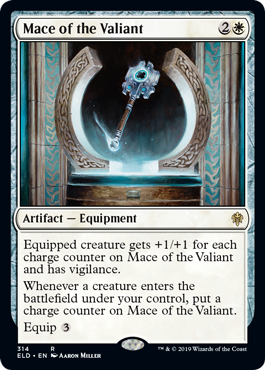
Mainly designed for the Chulane deck, since that deck was playing the most creatures. It needed a way to make a gigantic creature and punch through. Later, once we established that the Knight deck would be about Equipment, this card became key for that deck as well.
Silverwing Squadron and Embereth Skyblazer


Finishers for the Knight deck. Red and white have inherent weaknesses in multiplayer formats. They are the aggressive colors and do the most attacking. Since in multiplayer, your opponents have triple the amount of life than a single opponent has, we wanted to make stronger finishers that scale well in multiplayer.
Knights' Charge
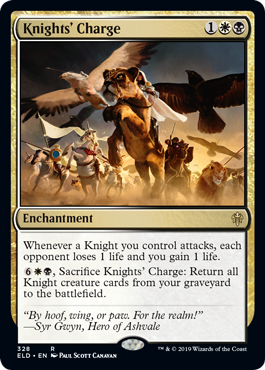
The Knight deck had a weaker late game than any of the other decks, so I designed a card that was useful both early and late. Once everyone used their sweepers, this card could threaten to return all your creatures at instant speed.
Steelbane Hydra
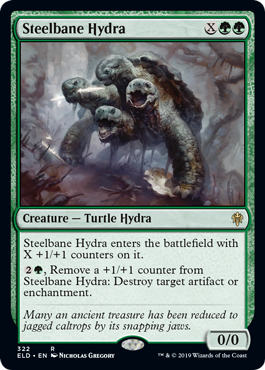
Artifacts and enchantments are widely played in both Commander and Brawl, and I wanted to make a creature that scales well as the game goes on while also being able to hose artifacts and enchantments. My inspiration for this card was Wickerbough Elder, and I've been trying to get a variant of this card in a set for a while. I finally found the place for it here.
Shimmer Dragon and Workshop Elders
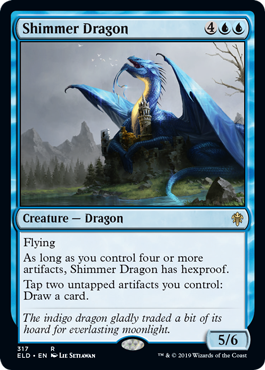
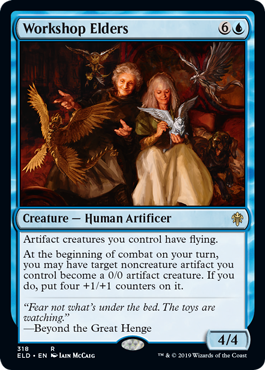
As you can see, a common theme among these decks is the lack of finishers. I wanted to make sure that the Alela deck had ways to close out games and gain card advantage while doing so. This was also a good chance to make a "Geppetto" card, and Workshop Elders started out as a top-down of that.
Thorn Mammoth
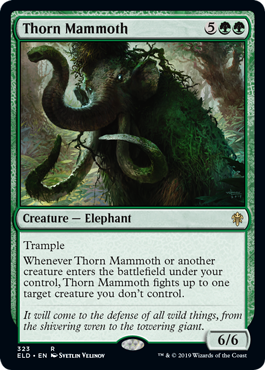
The playtest name for this was actually "Giant with Anger Issues," and I designed it for the Chulane deck because it needed more removal. This was a way to get more removal into the deck while also being a threat that could be interacted with.
Chittering Witch and Gluttonous Troll


Another opportunity to include multiplayer-focused cards. I wanted to make sure the Korvold deck had enough sacrifice outlets. While these cards are in the same spot on the curve, I wanted to make sure that there were enough redundant sacrifice effects. Since the output on each card is different, it gave the player some choices if both of them were in play.
Banish into Fable
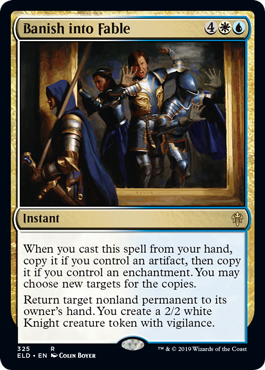
Many cards in the Alela deck reward you for controlling both artifacts and enchantments, so I wanted to design a card that did that. I also felt that the Alela deck wanted more interaction, so we combined those two goals on one card. This was actually designed by Great Designer Search 3 winner Ari Nieh.
Tome of Legends
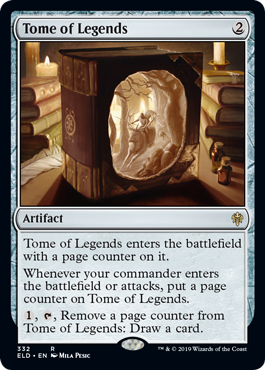
Also created by Ari Nieh, this card was designed to give decks more card flow, reward attacking, and be a cool option for Commander.
The Brawl Court
Well, with that said, what's left to do is. . .Brawl!
Us inside this building, and, as you now know, many people outside of it, put a lot of work into trying to make these decks great. It was a radical new way of building multiplayer decks, and each definitely has its own personality. Go give all four a try on MTG Arena—and check them out in stores in just a few weeks!
This is our big Brawl rollout, and I can't wait to see how you all like it.
Given how fresh and new of an approach this is, I would love to hear any thoughts you have on these decks after you've played with them! You can always reach me by sending over a tweet, asking me a question on my Tumblr, hitting me up on Instagram, or even sending me an email.
Have fun with your Courtside Brawls—and I'll see you on there!
—Gavin
Email: BeyondBasicsMagic@gmail.com
Instagram: GavinVerhey
Tumblr: GavInsight
Twitter: @GavinVerhey

























